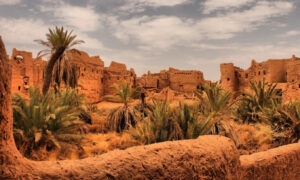
Impeccable architecture, ultra-modern cities, picturesque desert landscapes, and the world famous heritage sites are just a few adjectives to describe the inconceivable beauty of the Arab world. While many heritage travellers choose Europe, Asia, or America for satiating their quest for the historical sites and treasures, little do they know about the existence of some absolutely stupefying heritage wonders in the Middle East.
Yes, what you heard is correct; apart from the luxurious resorts, trendy beaches, fine dining places, and large theme malls of these multicultural cities of the Gulf Cooperation Council (GCC), there are a lot of truly inspiring historical destinations, both near as well as far from these grandiose cities.
Also, unlike many tourist destinations in other parts of the world, the ones in the Middle East aren’t greatly advertised outside their own territories. Now, you know why most travellers who want to have a glimpse of the Arab architectural marvels don’t have a great idea about the best places they should visit and what they should expect there. Don’t worry, if you’re planning to visit the Middle East and are wondering about the places that you could travel to, here are the best heritage destinations in the Gulf nations:
1) Pearling Trail, Bahrain

The Pearling Trail or the Pearling Pathway is the last known remains of what was once the biggest source of the wealth in the Gulf countries — the pearls. This must-visit heritage destination, located in the Muharraq island, is one of the only two UNESCO World Heritage sites in Bahrain. The pearl diving in this site dates back to 2000 BC, but we know for sure that the pearl trading was a key business from 2 AD till the early 20th Century, when the Japanese started developing cultured pearls. The 3.5 km-long Pearling Trail consists of 17 building in the town of Muharraq, a segment of the coast, three offshore oyster beds, and the Qal’at Bu Maher fortress.
2) Bahla Fort, Oman

A massive fort with a comprehensive design, the Bahla Fort is Oman’s only fort that finds a place in the UNESCO World Heritage List. The site is a two-hour drive from Muscat, and was open to public only since 2012, after the restoration program by the Oman government. While the oldest part of the walled city of Bahla, called Al Qabasah, is said to have been built as early as 500 AD, most of what you see now is after a series of restoration by the Nabhani tribe in the 13th Century, the Yaruba dynasty in the 17th Century, and the Busaidi tribe in the 19th Century. One of the exemplary ruins of the stunning Omani architecture, the walled fortress of Bahla includes many towers, wells, as well as mosques.
3) Mada’in Saleh, Saudi Arabia

A city carved out of colossal sandstone outcrop, Mada’in Saleh is known as the second capital of the ancient Nabatean civilization. However, it is more splendid and architecturally more sophisticated than the more famed Nabatean capital in Petra, Jordan. The unique sandstone cave structures feature multi-ethnic symbols and contain various tombs and ancient ruins of the ancient city, once known as Al-Hijr or Hegra by the Nabateans. This site was declared as the first UNESCO site in Saudi Arabia in 2008, and a must-visit for those who want to learn more about the pre-Islamic Saudi Arabia and the Nabatean people.
4) Al Zubarah, Qatar

Behind its impressive city walls lies what was once Qatar’s most thriving merchant centres and pearl trading and fishing ports. The fort was only built in the late 1930s under the supervision of Sheikh Abdullah bin Qassim Al Thani to serve as a military fortress and coast guard outpost, but the archaeological ruins of the site date back to the 1760s. The site has been inscribed in the list of UNESCO World Heritage sites and is now a museum to display artworks and other exhibits from the 18th and 19th century. Also, the design of the mighty fortress made of corals, limestones, and mortar in the picturesque setting of the northwestern coast of Qatar doesn’t fail to impress visitors.
5) Archaeological Sites of Bat, Al-Khutm, and Al-Ayn, Oman

Set on a ridge with a gorgeous mountain in the backdrop, the necropolises and the ancient ruins of Bat, Al-Khutm, and Al-Ayn gives you a peek into the settlements of the third millennium BC. The core prehistoric site lies in the modern-day village of Bat, while also extending to Al-Khutm, where you’ll find some monumental towers and to the necropolis of Al-Ayn. The bronze age burial sites and beehive tombs in such a surreal location simply take you to back to the prehistoric age.
6) Rock Art in the Ha’il Region, Saudi Arabia

The fourth Saudi Arabian site to be inscribed on the UNESCO World Heritage List, the Rock Art in the Ha’il region takes you on a journey tracing the ancestry of today’s Arab population. While the region of Ha’il has a number of rock art that dates back to the prehistoric age, the most important ones are Raat at Shuwaymis, Jabal al-Manjor, and Jabal Umm Sinman at Jubbah. The predominant subjects of these petroglyphs are horses and camels, apart from humans.
7) Historic Jeddah, the Gate to Makkah, Saudi Arabia

With a construction style so characteristic to the architects of the historic Red Sea coasts, the Historic Jeddah sheds a true light into the symbolic role it played as a gate to the Arab merchants sailing along the Indian Ocean trade route and the Muslim pilgrims who arrived by sea to visit the Holy Mecca for centuries. The impeccable design of the tower houses and the gorgeous wooden Roshan built there reflects the cultural and economic development of Jeddah as an urban centre. This mercantile & pilgrim destinations is rightly placed on the list of UNESCO World Heritage sites.
8) Cultural Sites of Al Ain, UAE

The oases of Al Ain and the regions of Hafit, Hili, and Bidaa Bint Saud are one of UAE’s top heritage attractions. Being the first site in UAE to be included in the list of UNESCO Heritage sites, this region in Abu Dhabi has truly managed to keep its tradition, heritage, and greenery intact, despite the huge development in the city. Al Ain, along with the neighbouring regions of Hafit, Hili, Bidaa Bint Saud, testifies to the human settlements in the desert dating back to the Neolithic age. While at Hili, you can see one of the oldest irrigation systems of the Iron Age — the Falaj Irrigation System. The regions of Hafit and Bidaa Bint Saud also preserve a lot of relics and prized objects from the Iron Age, making these regions some great places to explore for a true history enthusiast!
9) Frankincense – the wealth of Oman

The legendary Omani frankincense is often referred to as the wealth of Oman and has a great significance in the history and culture of Oman. Since the frankincense trees are on the verge of extinction, the areas where these ancient trees are found —Wadi Dawkah, Shishr, Khor Rori, and Al-Baleed — have been protected by UNESCO as a heritage site. You can take a frankincense trip around these archaeological sites in Oman to find out the incredible stories and legends behind frankincense and the reason why it has become such an inevitable part of the Omani culture, economy, and tradition.
If you’re a person who is interested in admiring the beauty of the ancient art and architecture, a visit to these amazing heritage sites in GCC could be more than worth it! The bewitching beauty of these ancient structures is sure to leave you dumbfounded by the top-notch engineering in the classic age.












